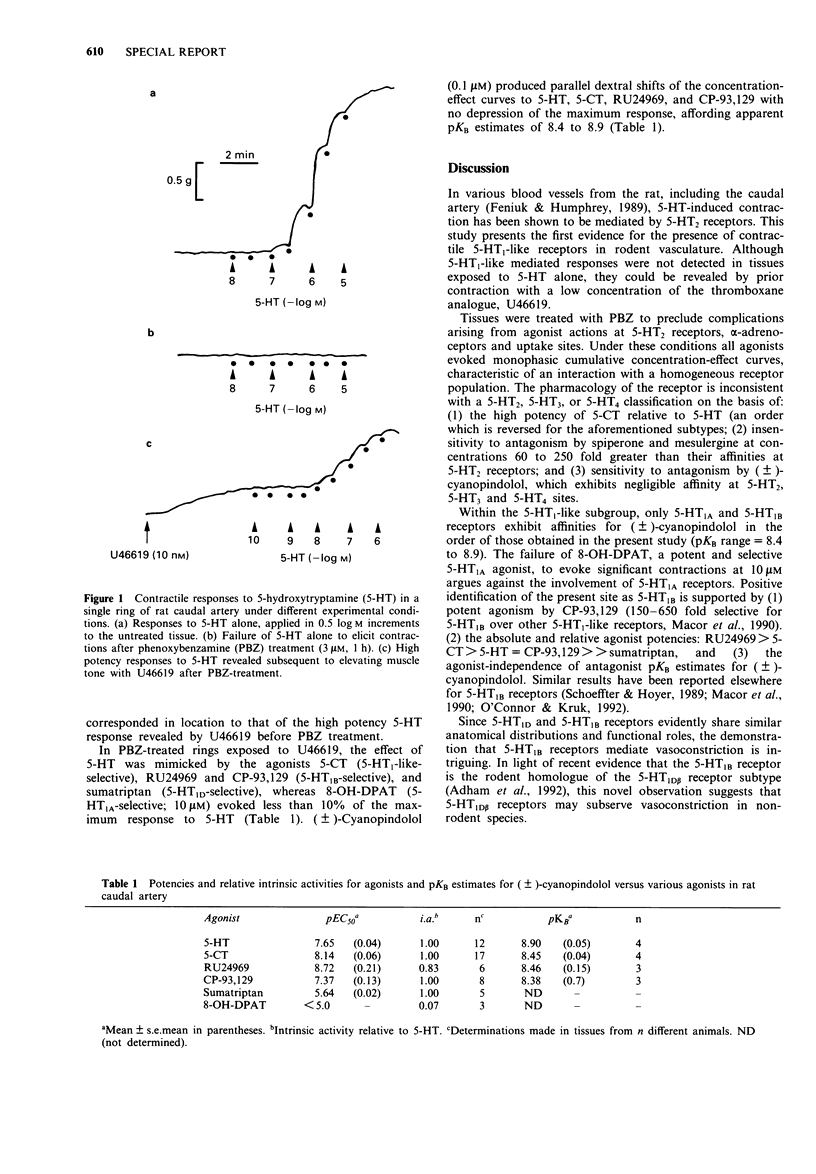Abstract
5-Hydroxytryptamine (5-HT) evoked potent contractile responses in phenoxybenzamine-treated ring segments of rat caudal artery, partially contracted with U46619. Responses were mimicked by 5-HT1-selective agonists with the potency order: RU24969 > 5-carboxamidotryptamine > 5-HT = CP-93,129 >> sumatriptan. 8-Hydroxy-N,N-dipropylaminotetralin was virtually inactive. Responses were unaffected by spiperone (0.1 microM) and mesulergine (1.0 microM), but were antagonized competitively by (+/-)-cyanopindolol affording agonist-independent pKB estimates of 8.4 to 8.9. The pharmacological profile of this receptor is consistent with that of the 5-HT1B subtype. Since the 5-HT1B receptor is the rodent homologue of the 5-HT1D beta subtype, it might be anticipated that 5-HT1D beta receptors will be found to mediate vasoconstrictor responses in non-rodent species.
Full text
PDF


Selected References
These references are in PubMed. This may not be the complete list of references from this article.
- Adham N., Romanienko P., Hartig P., Weinshank R. L., Branchek T. The rat 5-hydroxytryptamine1B receptor is the species homologue of the human 5-hydroxytryptamine1D beta receptor. Mol Pharmacol. 1992 Jan;41(1):1–7. [PubMed] [Google Scholar]
- Macor J. E., Burkhart C. A., Heym J. H., Ives J. L., Lebel L. A., Newman M. E., Nielsen J. A., Ryan K., Schulz D. W., Torgersen L. K. 3-(1,2,5,6-Tetrahydropyrid-4-yl)pyrrolo[3,2-b]pyrid-5-one: a potent and selective serotonin (5-HT1B) agonist and rotationally restricted phenolic analogue of 5-methoxy-3-(1,2,5,6-tetrahydropyrid-4-yl)indole. J Med Chem. 1990 Aug;33(8):2087–2093. doi: 10.1021/jm00170a007. [DOI] [PubMed] [Google Scholar]
- O'Connor J. J., Kruk Z. L. Pharmacological characteristics of 5-hydroxytryptamine autoreceptors in rat brain slices incorporating the dorsal raphe or the suprachiasmatic nucleus. Br J Pharmacol. 1992 Jul;106(3):524–532. doi: 10.1111/j.1476-5381.1992.tb14369.x. [DOI] [PMC free article] [PubMed] [Google Scholar]
- Perren M. J., Feniuk W., Humphrey P. P. Vascular 5-HT1-like receptors that mediate contraction of the dog isolated saphenous vein and carotid arterial vasoconstriction in anaesthetized dogs are not of the 5-HT1A or 5-HT1D subtype. Br J Pharmacol. 1991 Jan;102(1):191–197. doi: 10.1111/j.1476-5381.1991.tb12152.x. [DOI] [PMC free article] [PubMed] [Google Scholar]
- Schoeffter P., Hoyer D. 5-Hydroxytryptamine 5-HT1B and 5-HT1D receptors mediating inhibition of adenylate cyclase activity. Pharmacological comparison with special reference to the effects of yohimbine, rauwolscine and some beta-adrenoceptor antagonists. Naunyn Schmiedebergs Arch Pharmacol. 1989 Sep;340(3):285–292. doi: 10.1007/BF00168512. [DOI] [PubMed] [Google Scholar]
- Weinshank R. L., Zgombick J. M., Macchi M. J., Branchek T. A., Hartig P. R. Human serotonin 1D receptor is encoded by a subfamily of two distinct genes: 5-HT1D alpha and 5-HT1D beta. Proc Natl Acad Sci U S A. 1992 Apr 15;89(8):3630–3634. doi: 10.1073/pnas.89.8.3630. [DOI] [PMC free article] [PubMed] [Google Scholar]


